6.2 Setting Up Your Landing Page
After you enable a landing page as described in Section 6.1, Enabling the Landing Page View for a Workspace, you need to set it up to display the desired layout options and content, as described in the following sections:
6.2.1 Choosing Layout Options for Your Landing Page
-
Navigate to the landing page that you created in Section 6.1, Enabling the Landing Page View for a Workspace.
-
Click > in the Action toolbar.
or
If you are creating a landing page for a folder, click > .
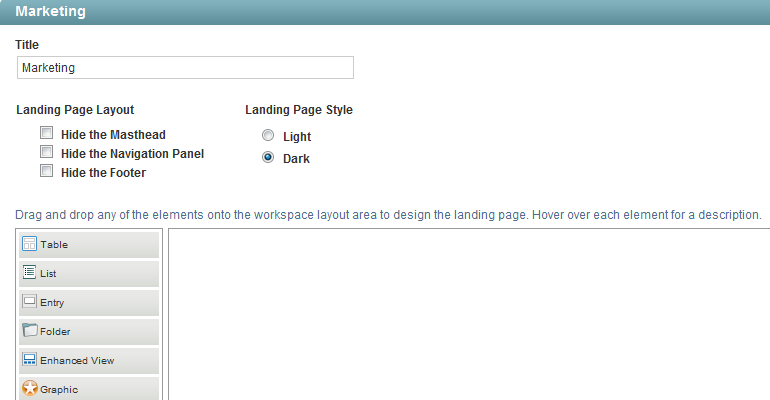
-
In the section, below the workspace field, select from the following options to modify the display of your landing page:
-
Hide the Masthead: Select this option to hide the masthead (Navigation toolbar). This hides everything above the Action toolbar.
-
Hide the Navigation Panel: Select this option to hide the Navigation panel.
-
Hide the Footer: Select this option to hide the Footer toolbar.
-
-
In the section, select from the following options to modify the style of your landing page:
-
Light: No background shading is displayed on landing page elements.
-
Dark: (Default) Displays a dark background on each element to provide contrast between the landing page elements.
-
-
Click to save the layout and style changes.
6.2.2 Adding Content to Your Landing Page
-
Navigate to the landing page that you created in Section 6.1, Enabling the Landing Page View for a Workspace.
-
Click > in the Action toolbar.
or
If you are creating a landing page for a folder, click > .

-
In the section, in the content editor, use the element palette to select the landing page element that you want to display on your landing page.
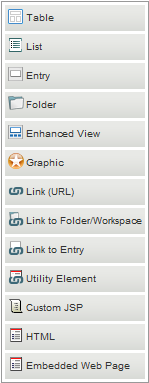
You can add the following elements:
-
Table: Creates a table with the number of columns that you specify. You can add other elements inside this table.
-
List: Creates a list where you can add other elements.
-
Entry: Enables you to reference an entry that has previously been created in Novell Vibe.
The actual content of your landing page is created in entries. The landing page simply references entries that have already been created within Vibe.
When you add an entry to the landing page by using the Entry element, only the entry title and description can be displayed. If you want to display entry comments, add the Enhanced View element to the landing page.
-
Folder: Enables you to reference a folder that has previously been created in Vibe. You can choose how many entries from the folder that you want to display on your landing page at any one time.
-
Enhanced View: Enables you to display entries and folders in enhanced ways. The following options are available:
-
Display an entry: Displays the entry title, description, author, date, and the 10 most recent comments.
-
Display a full entry: Displays the entry with the full entry view, which includes the title, description, author, date, tabs (, , , ), ratings, and so forth.
-
Display recent entries: Displays the most recent entries from the specified folder. Displays the title, description, author, date, and the 10 most recent comments for each entry.
-
Display a list of recent entries: Displays a list of the most recent entries from the specified folder. Displays the title, author, and date of the entry.
-
Display a sorted list of recent entries: Displays a list in alphabetical order of the most recent entries from the specified folder. Displays the title, author, and date of the entry.
-
Display a sorted list of files: Displays a list in alphabetical order of the files that were most recently added to the folder. This includes files that are attached to entries.
-
Display calendar: Displays the specified calendar with the full calendar view.
-
Display task folder: Displays the specified task folder with information about each task, such as the title, due date, priority, and so forth.
-
Display survey: Displays the specified survey in a full, interactive view. Users can participate in the survey directly from the landing page.
-
-
Graphic: Enables you to reference a graphic that has previously been added to the workspace.
-
Link (URL): Enables you to create a link to a Web URL.
-
Link to Folder/Workspace: Enables you to add a link to a Vibe folder or workspace.
-
Link to Entry: Enables you to add a link to a Vibe entry.
-
Utility Element: Enables you to add various utilities, such as the My Workspace link.
-
Custom JSP: Enables you to reference a custom JSP file that has previously been created by a Vibe administrator.
-
HTML: Displays an HTML editor where you can compose messages, create links, upload pictures, and more. The information that you create in this HTML editor is displayed on your landing page.
-
Embedded Web Page: Enables you to reference any Web site and display it on your landing page.
-
-
Drag the element that you want to display on your landing page and drop it onto the landing page canvas.
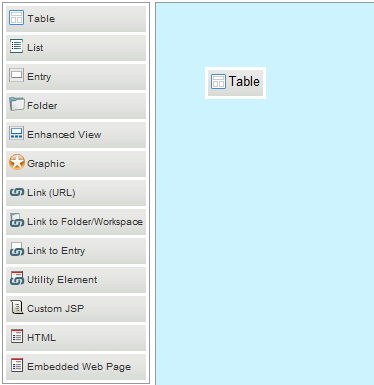
After you drop the element onto the landing page canvas, you are prompted to configure it.
How you configure a landing page element depends on the type of element that you add.
-
Configure the landing page element as described in Section 6.2.3, Configuring Landing Page Elements.
6.2.3 Configuring Landing Page Elements
You need to configure the elements of your landing page when you create them, as described in Section 6.2.2, Adding Content to Your Landing Page.
You can also reconfigure the elements of your landing page at any time, as described in Section 6.4, Modifying the Contents of Your Landing Page.
After you have added and configured the elements of your landing page, you are ready to publish the landing page. For information on how to do this, see Section 6.3, Publishing Your Landing Page.
Adding a Table
To add a table to the landing page:
-
In the section, in the content editor, click in the element palette, then drag the table into the desired area of the landing page canvas.
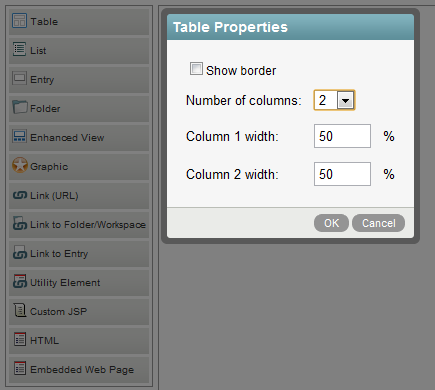
-
Set the following configuration options to finish setting up the table:
-
Show border: Select this option if you want the border of the table to be visible.
-
Number of columns: Specify the number of columns that you want the table to have. You can have up to five columns.
-
Column 1 width: Specify the width that you want the first column to have.
If your table has multiple columns, you can specify the width for each column.
-
-
Click .
After you add a table to a landing page, you can add content within the table.
-
Select an element from the element palette and drag and drop it into the location of the table where you want to add the content.
Adding a List
To add a list to the landing page:
-
In the section, in the content editor, click in the element palette, then drag the list and drop it into the desired area of the landing page canvas.
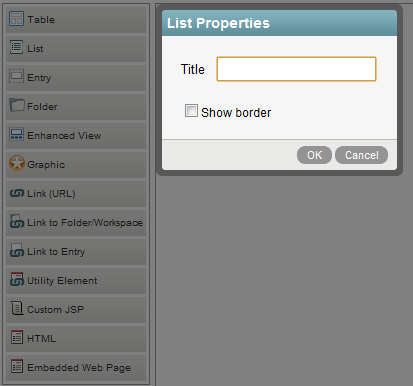
-
Set the following configuration options to finish setting up the list:
-
Title: Specify a title for the list.
-
Show border: Select this option if you want the border of the list to be visible.
-
-
Click .
After you add a list to a landing page, you can add content within the list.
-
Select an element from the element palette and drag and drop it into the location of the list where you want to add the content.
Adding an Entry
The actual content of your landing page is created in entries. The landing page simply references entries that have already been created within Vibe.
When you use the Entry element to add an entry to the landing page, only the entry title and description can be displayed. If you want to display entry comments, add the Enhanced View element to the landing page, as described in Adding an Enhanced View Element.
To add an entry to the landing page:
-
In the section, in the content editor, click in the element palette, then drag the entry into the desired area of the landing page canvas.
-
Click next to the field.
If you are reconfiguring the element, the entry that is being referenced is shown here.
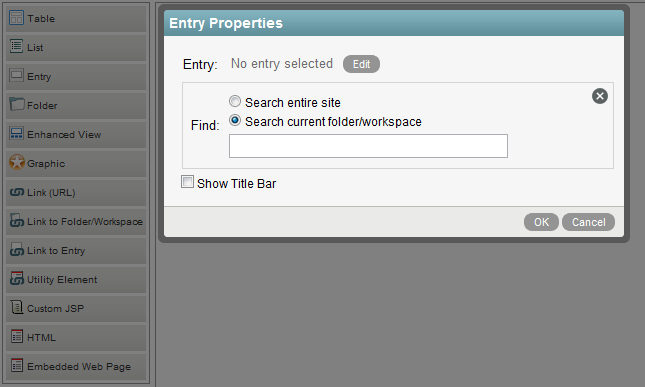
-
Set the following configuration options to finish setting up the entry:
-
Find: Select whether you want to search the entire site for the entry or only within the current folder or workspace, then use the provided field to specify the entry that you want to display on the landing page.
This field uses type-to-find functionality, so Vibe displays the available options as you type. Click in the field and press the Spacebar to list all the available options.
-
Show Title Bar: Select this option if you want the title bar of the entry to be visible.
-
-
Click .
Adding a Folder
-
In the section, in the content editor, click in the element palette, then drag the folder into the desired area of the landing page canvas.
-
Click next to the field.
If you are reconfiguring this element, the folder that is being referenced is shown here.
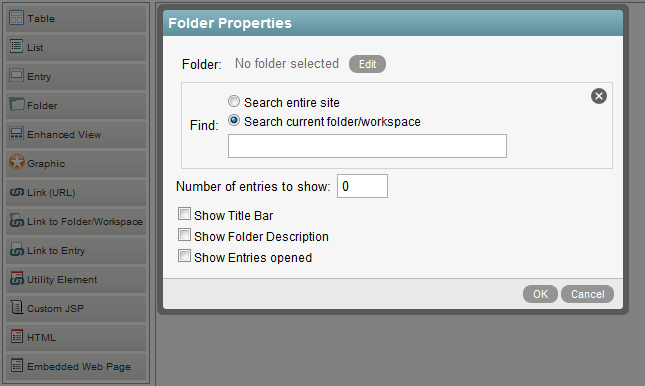
-
Set the following configuration options to finish setting up the folder:
-
Find: Select whether you want to search the entire site for the folder or only within the current folder or workspace, then use the provided field to specify the folder that you want to display on the landing page.
This field uses type-to-find functionality, so Vibe displays the available options as you type. Click in the field and press the Spacebar to list all the available options.
-
Number of entries to show: Specify the number of folder entries that you want to be displayed at any one time.
-
Show Title Bar: Select this option if you want the folder title bar to be displayed.
-
Show Folder Description: Select this option if you want the folder description to be displayed.
-
Show Entries Opened: Select this option if you want opened entries to be displayed.
-
-
Click .
Adding an Enhanced View Element
-
In the section, in the content editor, click in the element palette, then drag the enhanced view into the desired area of the landing page canvas.
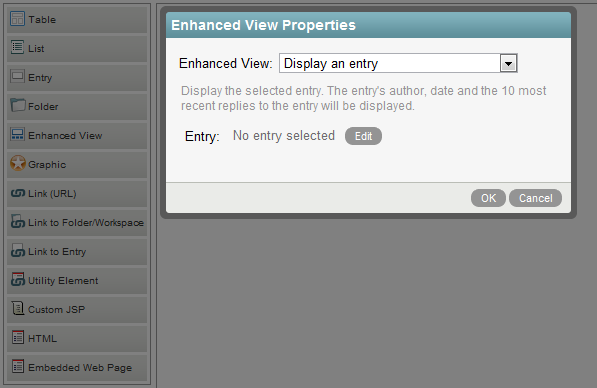
-
In the drop-down list, select one of the available options.
For more information about each option, see Enhanced View.
-
Set the configuration options that apply to the enhanced view element that you are adding. Depending on the option that you selected in Step 2, the following configuration options are available:
-
Entry: Click .
If you are reconfiguring this element, the folder that is being referenced is shown here.
-
Folder: Click .
If you are reconfiguring this element, the folder that is being referenced is shown here.
-
Find: Select whether you want to search the entire site for the folder or entry, or only within the current folder or workspace, then use the provided field to specify the folder or entry that you want to display on the landing page.
-
Number of entries to show: (Conditional) Specify the number of folder entries that you want to be displayed at any one time.
This option is available only when referencing a folder.
-
Width: (Conditional) Specify the width that you want the calendar to be on the landing page, either by percent or pixels.
This option is available only when you are adding a calendar.
-
Height: (Conditional) Specify the height that you want the calendar to be on the landing page, either by percent or pixels.
This option is available only when you are adding a calendar.
-
Show Title Bar: Select this option if you want the title bar to be displayed.
This option is available depending on what you select in the drop-down list.
-
-
Click .
Adding a Graphic
Before you can add a graphic to your landing page, you need to attach the graphic to the landing page, as described in Section 6.9, Enabling Graphics to Be Used on a Landing Page.
-
In the section, in the content editor, click in the element palette, then drag the graphic into the desired area of the landing page canvas.
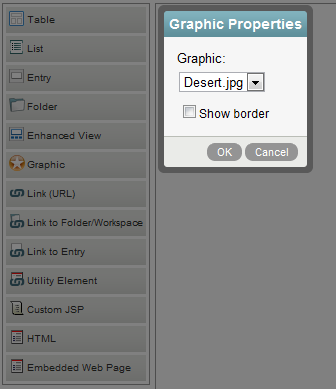
-
Set the following configuration options to finish setting up the graphic:
-
Graphic: In the Graphic drop-down list, select the graphic that you want to display.
All attachments that are attached to the landing page workspace are displayed in this list. Attachments are also displayed in the section at the bottom of the page.
-
Show border: Select this option if you want the border of the graphic to be visible.
-
-
Click .
Adding a Link (URL)
-
In the section, in the content editor, click in the element palette, then drag the link element into the desired area of the landing page canvas.
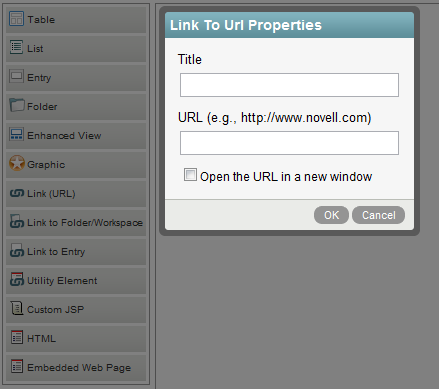
-
Set the following configuration options to finish setting up the URL link:
-
Title: Specify the title that you want to be displayed.
-
URL: Specify the URL that you want to link to.
To link to a URL outside of Vibe, you must include http:// at the beginning of the URL.
To link to a page within Vibe, the best method is to use the Link to Folder/Workspace element or the Link to Entry element.
An alternative is to paste a Vibe permalink into this field. To get the permalink URL of a Vibe page, simply navigate to the page that you want to link to, click in the footer toolbar, then copy the permalink URL from the field.
-
Open URL in a new window: Select this option if you want to open the URL in a new browser window.
-
-
Click .
Adding a Link to a Folder/Workspace
You can create a link to any folder or workspace for which you have appropriate rights.
-
In the section, in the content editor, click in the element palette, then drag the link element into the desired area of the landing page canvas.
-
Click next to the field.
If you are reconfiguring the element, the folder or workspace that is being referenced is shown here.
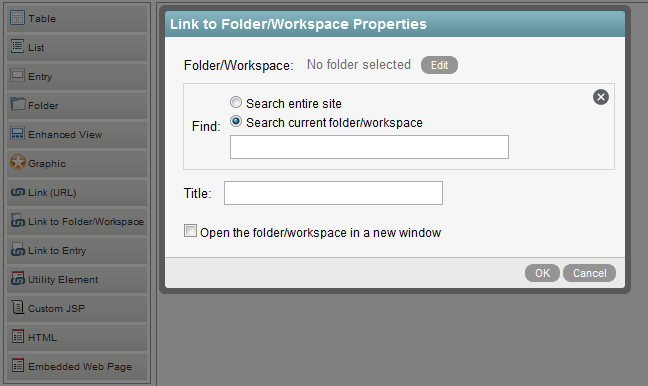
-
Set the following configuration options to finish setting up the link:
-
Find: Select whether you want to search the entire site for the folder or only within the current folder or workspace, then use the provided field to specify the folder or workspace that you want to link to.
This field uses type-to-find functionality, so Vibe displays the available options as you type.
-
Title: Specify a title for the link.
-
Open the folder/workspace in a new window: Select this option if you want to open the folder or workspace in a new browser window.
-
Adding a Link to an Entry
Enables you to create a link to any entry for which you have appropriate rights.
-
In the section, in the content editor, click in the element palette, then drag the link element into the desired area of the landing page canvas.
-
Click next to the field.
If you are reconfiguring the element, the entry or workspace that is being referenced is shown here.
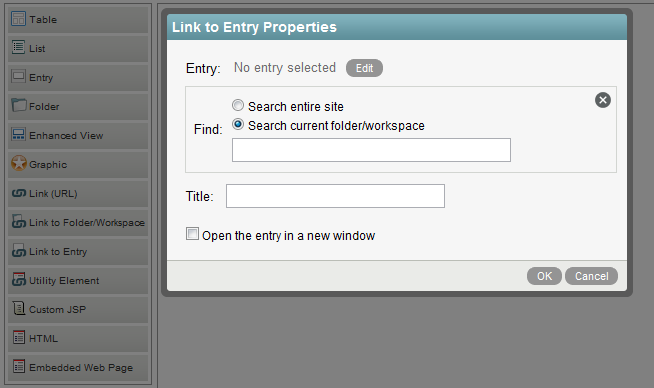
-
Set the following configuration options to finish setting up the link:
-
Find: Select whether you want to search the entire site for the entry or only within the current folder or workspace, then use the provided field to specify the entry that you want to link to.
This field uses type-to-find functionality, so Vibe displays the available options as you type.
-
Title: Specify a title for the link.
-
Open the entry in a new window: Select this option if you want to open the entry in a new browser window.
-
Adding a Utility Element
Most utility elements are options that are normally displayed either in the Vibe masthead or Navigation panel; however, because it is often desirable to hide the masthead and Navigation panel in order to make more room for information on your landing page, utility elements enable you to display important features in a more concise view.
-
In the section, in the content editor, click in the element palette, then drag the utility into the desired area of the landing page canvas.
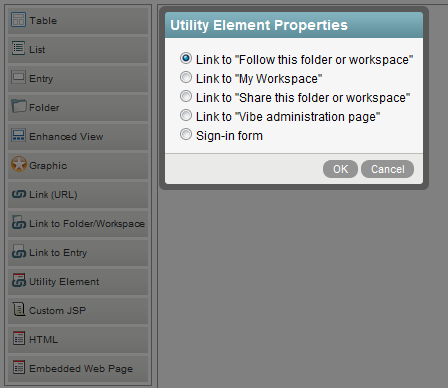
-
Select from the following utility elements:
Link to “Follow this folder or workspace”: Displays a or r link.
Link to “My Workspace”: Displays a link to your personal workspace.
Link to “Share this folder or workspace”: Displays a or link.
Link to “Vibe administration page”: Provides a link to the Vibe Administration page.
This link is visible only to Vibe users who have administrative rights.
Sign-in form: Displays a Sign In form when users are not logged in to Vibe.
-
Click .
Adding a Custom JSP
Custom JSP files are stored in the WEB-INF\jsp\custom_jsps directory. If you want to include a custom JSP file in your landing page, you must store the file in this directory in order to reference it from Vibe.
Typically, only Vibe administrators have access to this directory. If you want to create a custom JSP file, consult your Vibe administrator.
After the custom JSP file has been placed in the WEB-INF\jsp\custom_jsps directory:
-
In the section, in the content editor, click in the element palette, then drag the JSP element into the desired area of the landing page canvas.
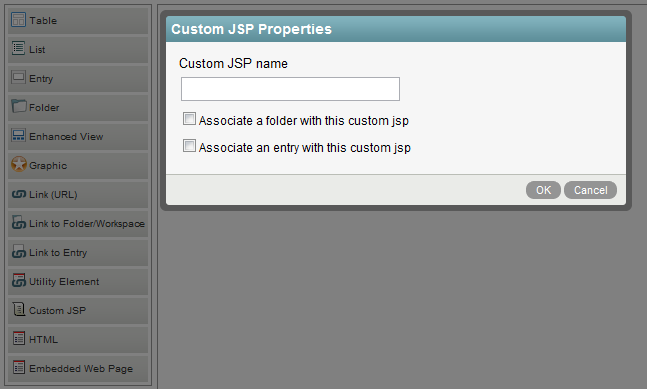
-
In the field, type the name of the custom JSP file that you want to reference.
You must obtain this filename from your Vibe administrator. Only your Vibe administrator can enable JSP files to be used in the Vibe site.
-
Depending on how you want to use this custom JSP file, select either , or .
For example, if your administrator has enabled a custom JSP file that enhances the way entries are displayed on the landing page, and you want to utilize this JSP file for a specific folder, you would select .
-
Click next to the field.
If you are reconfiguring the element, the field displays the folder that the custom JSP file is currently associated with. If you are creating a new element, this field is blank.
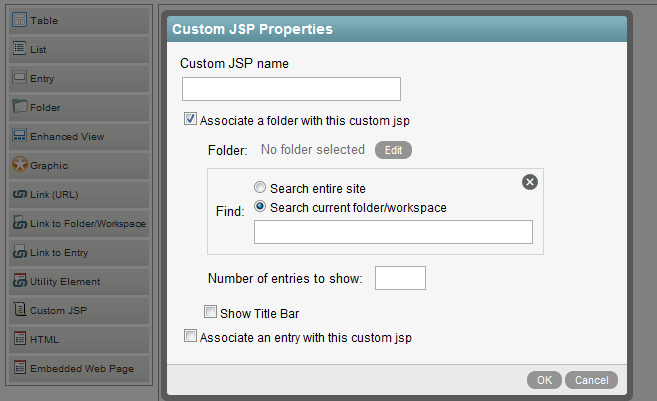
-
Set the appropriate configuration options to finish setting up the custom JSP:
Find: Select whether you want to search the entire site for the folder or only within the current folder or workspace, then use the provided field to specify the folder that you want to associate the JSP file with.
This field uses type-to-find functionality, so Vibe displays the available options as you type.
Number of entries to show: Specify how many folder entries you want to be displayed on the landing page at any one time.
Show Title Bar: Select this option if you want the title bar of the entry to be visible.
-
Click .
Adding an HTML Editor
To add content (such as text, links, pictures, and videos) to your landing page by using an HTML editor:
-
In the section, in the content editor, click in the element palette, then drag the HTML element into the desired area of the landing page canvas.
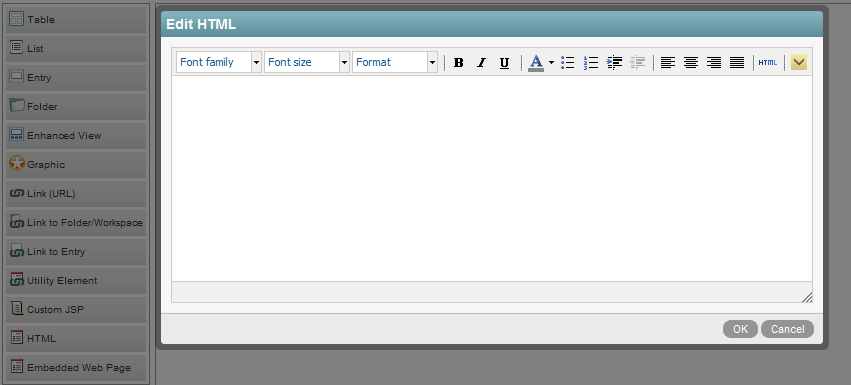
-
Specify content in the HTML editor that you want to be displayed on the landing page. Click the icon
 to show and hide additional options.
to show and hide additional options.
-
Click .
Adding an Embedded Web Page
-
In the section, in the content editor, click in the element palette, then drag the page into the desired area of the landing page canvas.
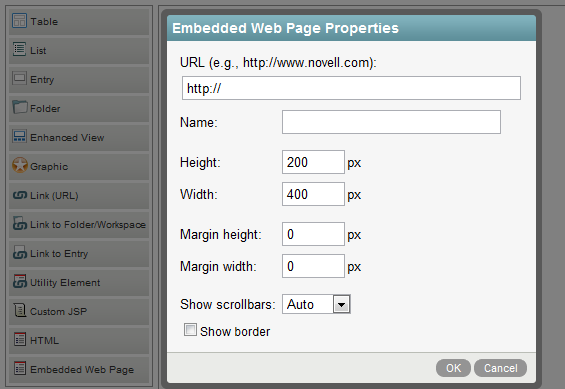
-
Set the following configuration options to finish setting up the embedded Web page:
-
URL: Specify the URL for the embedded Web page that you want to display.
-
Name: Specify a name for the page. This name is displayed on the landing page above the embedded Web page.
-
Height: Specify the height (in pixels) to indicate how much of the page you want to display.
-
Width: Specify the width (in pixels) to indicate how much of the page you want to display.
-
Margin height: Adds margin to the top and bottom of the embedded Web page.
This function is not supported on all browsers.
-
Margin width: Adds margin to the right and left sides of the embedded Web page.
This function is not supported on all browsers.
-
Show scrollbars: Select whether you want to display scroll bars. Keep the default of if you want Vibe to auto detect whether scroll bars are needed.
-
Show border: Select whether you want to display a border around the embedded Web page.
-
-
Click .